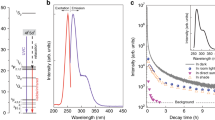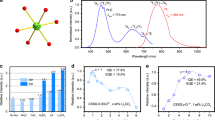Abstract
Visible-light persistent phosphors are being widely used as self-sustained night-vision materials because of their sufficiently strong and long afterglow (>10 h) and their ability to be excited by sunlight as well as room light. In contrast, persistent phosphors for near-infrared (NIR) wavelengths are lacking. Here we report a series of Cr3+-doped zinc gallogermanate NIR persistent phosphors that exhibit strong emission at 650–1,000 nm, extending beyond the typical 690–750 nm, and with a super-long afterglow of more than 360 h. These new NIR persistent phosphors are all-weather materials that can be rapidly, effectively and repeatedly charged by natural sunlight in almost all kinds of outdoor environment. Seconds to minutes of sunlight activation can result in more than two weeks of persistent NIR light emission. This new series of NIR persistent materials have potential applications in night-vision surveillance, solar energy utilization and in vivo bio-imaging.
This is a preview of subscription content, access via your institution
Access options
Subscribe to this journal
Receive 12 print issues and online access
$259.00 per year
only $21.58 per issue
Buy this article
- Purchase on Springer Link
- Instant access to full article PDF
Prices may be subject to local taxes which are calculated during checkout





Similar content being viewed by others
References
Hölsä, J. Persistent luminescence beats the afterglow: 400 years of persistent luminescence. Electrochem. Soc. Interf. 18, 42–45 (2009).
Yen, W. M., Shionoya, S. & Yamamoto, H. Phosphor Handbook (CRC Press, 2007).
Matsuzawa, T., Aoki, Y., Takeuchi, N. & Murayama, Y. A new long phosphorescent phosphor with high brightness, SrAl2O4:Eu2+, Dy3+. J. Electrochem. Soc. 143, 2670–2673 (1996).
Yamamoto, H. & Matsuzawa, T. Mechanism of long phosphorescence of SrAl2O4:Eu2+, Dy3+ and CaAl2O4:Eu2+, Nd3+. J. Lumin. 72, 287–289 (1997).
Wang, X. X., Zhang, Z. T., Tang, Z. L. & Lin, Y. H. Characterization and properties of a red and orange Y2O2S-based long afterglow phosphor. Mater. Chem. Phys. 80, 1–5 (2003).
De Chermont, Q. L. M. et al. Nanoprobes with near-infrared persistent luminescence for in vivo imaging. Proc. Natl Acad. Sci. USA 104, 9266–9271 (2007).
Yu, N. Y., Liu, F., Li, X. F. & Pan, Z. W. Near infrared long-persistent phosphorescence in SrAl2O4:Eu2+, Dy3+, Er3+ phosphors based on persistent energy transfer. Appl. Phys. Lett. 95, 231110 (2009).
Yan, W. Z. et al. Near infrared long-persistent phosphorescence in La3Ga5GeO14:Cr3+ phosphor. Opt. Express 18, 20215–20221 (2010).
Jia, D., Lewis, L. A. & Wang, X. J. Cr3+-doped lanthanum gallogermanate phosphors with long persistent IR emission. Electrochem. Solid-State Lett. 13, J32–J34 (2010).
Bessière, A. et al. ZnGa2O4:Cr3+: A new red long-lasting phosphor with high brightness. Opt. Express 19, 10131–10137 (2011).
Struve, B. & Huber, G. The effect of the crystal field strength on the optical spectra of Cr3+ in gallium garnet laser crystal. Appl. Phys. B 36, 195–201 (1985).
Forster, L. S. The photophysics of chromium(III) complexes. Chem. Rev. 90, 331–353 (1990).
Szymczak, H., Wardzynska, M. & Mylnikova, I. E. Optical spectrum of Cr3+ in the spinel LiGa5O8 . J. Phys. C 8, 3937–3943 (1975).
Macfarlane, P. I., Han, T. P. J., Henderson, B. & Kaminskii, A. A. Cr3+ luminescence in calcium and strontium gallogermanate. Opt. Mater. 3, 15–24 (1994).
Kaminskii, A. A. et al. Tunable stimulated-emission of Cr3+ ions and generation frequency self-multiplication effect in acentric crystals of Ca-gallogermante structure. Inorg. Mater. 24, 579–581 (1988).
Pan, Z. W. & Lu, Y-Y. T Near infrared doped phosphors having a zinc, germanium, gallate matrix. University of Georgia Research Foundation, PCT/US patent application WO 2011/035292 A2 (2011).
Rack, P. D., Peterson, J. J., Potter, M. D. & Park, W. Eu+3 and Cr+3 doping for red cathodoluminescence in ZnGa2O4 . J. Mater. Res. 16, 1429–1433 (2001).
Grinberg, M. Spectroscopic characterisation of disordered materials doped with chromium. Opt. Matter 9, 37–45 (2002).
Trojan-Piegza, J., Niittykoski, J., Hölsä, J. & Zych, E. Thermoluminescence and kinetics of persistent luminescence of vacuum-sintered Tb3+-doped and Tb3+, Ca2+-codoped Lu2O3 materials. Chem. Mater. 20, 2252–2261 (2008).
Delbecq, C. J., Toyozawa, Y. & Yuster, P. H. Tunneling recombination of trapped electrons and holes in KCl:AgCl and KCl:TlCl. Phys. Rev. B 9, 4497–4505 (1974).
Avouris, P. & Morgan, T. N. A tunneling model for the decay of luminescence in inorganic phosphor: The case of Zn2SiO4:Mn. J. Chem. Phys. 74, 4347–4355 (1981).
Acknowledgements
We acknowledge financial support from the US Office of Naval Research (N00014-07-1-0060), the National Science Foundation (CAREER DMR-0955908), the American Chemical Society Petroleum Research Fund (PRF 50265-DN10) and the University of Georgia Research Foundation. We thank R. S. Meltzer for discussions.
Author information
Authors and Affiliations
Contributions
Z.P. conceived and designed the experiments, and was responsible for the project planning. Y-Y.L. and F.L. carried out material synthesis and spectral measurements. F.L. investigated the persistent luminescence mechanism. Z.P. and F.L. carried out the NIR imaging. Z.P. and F.L. co-wrote the paper. All of the authors discussed the results.
Corresponding author
Ethics declarations
Competing interests
The authors declare no competing financial interests.
Supplementary information
Supplementary Information
Supplementary Information (PDF 1501 kb)
Rights and permissions
About this article
Cite this article
Pan, Z., Lu, YY. & Liu, F. Sunlight-activated long-persistent luminescence in the near-infrared from Cr3+-doped zinc gallogermanates. Nature Mater 11, 58–63 (2012). https://doi.org/10.1038/nmat3173
Received:
Accepted:
Published:
Issue Date:
DOI: https://doi.org/10.1038/nmat3173
This article is cited by
-
Charge trapping for controllable persistent luminescence in organics
Nature Photonics (2024)
-
Bright and stable perovskite light-emitting diodes in the near-infrared range
Nature (2023)
-
Intervalence charge transfer of Cr3+-Cr3+ aggregation for NIR-II luminescence
Light: Science & Applications (2023)
-
Bright and stable near-infrared perovskite light emitters supported by multifunctional molecule design strategy
Light: Science & Applications (2023)
-
Red/NIR/SWIR multi-band persistent luminescent nanoparticles as ultrasensitive multi-channel tracers in water and crude oil/water emulsions
Nano Research (2023)



